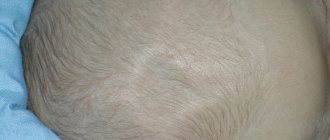Moles in newborns.
Many people are sure that moles are spots on our body that we were born with.
However, is this really true? In fact, quite a few children are born with moles on their bodies. Moles got their name for a different reason. First of all, moles, or nevi, are transmitted genetically through parents. Hence the name “moles”. Popular moles that a child had at birth are called birthmarks. Such spots actually appear with the birth of a child and grow with the growth of the newborn. The question of when moles appear in newborns may sound incorrect. The fact is that birthmarks on the body of a newborn can be noticeable, or they can be barely visible. At first they appear as a bright spot that is difficult to see with the naked eye. Over time, the spot becomes darker, and you realize that your child has a “birthmark”. By the way, many parents are proud of their birthmarks, which are passed on from generation to generation, so the appearance of a pedigree birthmark on a child is eagerly awaited.
Many people are interested in the question of why moles appear in children.
- Genetics. First of all, it’s all about a genetic predisposition to this, for example, dad or more likely mom has the same mole in the same place or nearby. There's nothing you can do about it. But it happens that children develop moles that do not decorate them in any way, but they should not be removed while the child is very small, because The nevus may appear again and you will have to have surgery again.
- Hormones. This is also a common cause of moles in children, but it is extremely rare that it occurs in infancy.
- UV rays. Newborns do not sunbathe or go to the beach with their parents, so this option is also excluded.
In addition, you can independently understand in advance with a high probability of coincidence that the child will have a birthmark at birth. The fact is that most often the following are born with nevi:
- Light-skinned children
- Girls (about 4-5 times more often than boys),
- Premature babies.
Is the appearance of new moles dangerous?
Initially, nevi resemble pigment spots that appear anywhere, including the head, mouth and tongue. Over time, they change size, color and shape, and may disappear altogether. Flat spots can take on a convex shape. Such light brown marks are absolutely harmless and are the most common in humans.
The formation of spots throughout life is a natural process. There's nothing wrong with that. But some of them are worth showing increased interest. In rare cases, they indicate the development of a malignant tumor or require urgent surgical intervention.
Which moles are dangerous?
Any nevus is more or less dangerous. Throughout life, they may not bother their owner. There is a small chance that benign neoplasms, under the influence of various factors, can eventually develop into a serious disease - melanoma. The disease quickly spreads to all cells of the body.
Worms have a negative impact, primarily endangering the immune system, which fights and protects a person from various diseases.
Parents should be wary in the following cases:
- A mole with uneven edges.
- The nevus has an uneven color and long hairs appear.
- A child’s mole grows, reaching unnatural sizes.
- The structure of the spots is heterogeneous.
It is worth considering the “dangerous” marks in detail.
If the size of the birthmark increases as the child grows, then you should worry. Another reason for concern is the change in color. It is important to compare all the marks; if one is noticeably different from the others, then you should see a doctor.
Separately, it is worth mentioning the peculiar spots. This group includes raised markings, star-shaped, with jagged borders, or markings of different colors (red, pink, black, brown). Such features indicate Spitz nevus. The disease poses a danger to human life. At first glance, it is easy to confuse it with melanoma.
Bleeding nevi may also occur. You should be wary if they start to bleed. The cause of the formation of blood spots may be injury to nevi.
There are cases when the diameter of the birthmark can exceed 15 centimeters. Such marks can be on the body from the moment of birth and can later develop into melanoma.
Moles in children.
Most often, the first nevi appear in childhood. But when children have moles, only parents know who remember every centimeter of the child’s body. It is impossible to say specifically that moles in children appear strictly at 3 years or at 5 years - everything is individual and depends on several factors:
- Child maturation
- Staying in the sun
- Genetics.
A genetic predisposition cannot be ruled out, so if the parents’ first moles appeared late, then the child will probably not get moles early, and if the parents have a lot of moles, then the baby will have a lot of moles.
Attention! To protect your child from the appearance of new moles, try to protect him from sun exposure, especially from sunburn. In summer, the baby should wear clothing (not warm) that covers exposed skin, such as a Panama hat. Always apply sunscreen to your child's skin before leaving the house, and at the beach, make sure he plays in the shade, such as under a beach umbrella.
So at what age do moles appear? According to statistics, the first moles appear in children at the age of 1-2 years. By this age, children are taken with them to the dacha or to the beach for a couple of hours, but this is already enough for the mole to appear. Daily walks along the street and park are enough, because... ultraviolet rays cause the appearance of new nevi.
If you are concerned that your child is developing moles, contact your pediatrician or immediately see a dermatologist who will examine the child and the growths and can tell you whether there is a danger from moles on the body. However, malignant moles in a child are extremely rare, but still watch how the mole develops and grows, how it manifests itself and how the child reacts to it.
Types of neoplasms, mechanism of occurrence and care
The mechanism of the appearance of a neoplasm directly depends on its type. There are these types of moles:
- Small spots of red color. They are most often observed in newborns. The location of such spots is usually the forehead, the back of the head, and the bridge of the nose. They appear as a result of intrauterine friction against the mother's bones. Typically, such spots gradually disappear during the first year of the baby's life.
- Flat moles of burgundy color. They are areas with dilated blood vessels. The location of such moles is the face or head. They continue to grow over time and may gradually become pathological. Therefore, such tumors require removal. They don't go away on their own.
- Flat brown spots. Their color can vary in shades of brown. When palpating, no pathological compactions are felt. In some cases, they gradually disappear, but they can remain for life. They do not pose a danger and therefore do not require removal.
Strawberry hemangioma. It is a convex neoplasm of a bright red or burgundy hue. When palpated, the neoplasm is soft. Most often, this is a congenital pathology or occurs in the first weeks of a baby’s life. Most often, experts do not recommend getting rid of such moles, despite the discomfort from an aesthetic point of view. Since any impact on strawberry hemangioma can lead to dangerous consequences.- Cavernous hemangioma. These are neoplasms on the skin, which are large elements of blood vessels with unclear boundaries. These birthmarks should not be treated. Because by puberty they disappear on their own.
In order to avoid complications, special care for moles is needed. It provides for compliance with the following rules:
- Birthmarks should not be covered with adhesive tape;
- avoid prolonged exposure to direct sunlight;
- After swimming in ponds, the child’s skin must be wiped dry; moisture can cause burns on age spots;
- If a child’s mole is injured, a sterile bandage should be applied to it, and then immediately consult a doctor.
Damaged birthmarks should never be treated with antiseptic agents. This can significantly worsen the condition. Simply rinse the affected area.
Removal of a mole in children should occur exclusively in a hospital setting. This should not be done at home. There are several methods for removing spots on the skin, namely:
- laser exposure,
- electrocoagulation,
- removal with liquid nitrogen.
Watch a video on this topic:
After these procedures, you must strictly adhere to the doctor’s recommendations for faster healing of the wound.
Moles in a child are a natural phenomenon. They do not cause any harm to the small organism. But parents often worry about spots on their baby’s body. Therefore, people often wonder when do children get moles?
Such different “children’s” moles...
It is rare to see the moles that we are used to seeing in children. But still, congenital birthmarks are those that appeared immediately after birth or appeared in the first 2-3 months of the baby’s life.
Moles can be:
- Vascular,
- Not vascular or ordinary.
Moles that consist of many blood vessels are called vascular. The color of these moles varies from pink to bright red. Vascular nevi can be either flat or convex. These moles are benign, but they are removed not because of the fear of melanoma, but because of their appearance.
Non-vascular moles have a smooth surface, appear in the first years of a child's life and can range in color from light brown to black. Such moles can be either flat or convex; hair growing from the mole is often considered a good sign. You should worry about moles on your palms or soles, because... Such nevi are extremely easy to damage.
Separately, it is worth highlighting vascular moles in a child. Pay attention to whether there are pinkish-red or bluish spots on the child’s body with a slight swelling in diameter? If there is, you should consult a doctor. Vascular nevi are:
- Hemangiomas,
- Stork bites or salmon-colored birthmarks,
- Port wine stain or flaming nevus.
Hemangioma may not be visible immediately, because... for the first time it appears only 2-3 weeks or even 6-12 months after the birth of the baby. It appears anywhere and can grow quickly, although after 1-1.5 years it usually turns pale and flesh-colored. In most children, hemangioma goes away by the age of 10.
“Stork bite” is most common and appears on the back of the head, bridge of the nose and eyelids in the form of a large pink spot or a cluster of small spots.
Flaming nevus is most often flat and red, appears on the face or scalp and grows as the baby ages and grows. Over time, the “wine stain” does not disappear, it cannot be removed, and it is pointless, but you can undergo treatment with the help of:
- Infrared radiation;
- Laser therapy.
If the stain cannot be cured, try either removing it if it is bothering you or hiding it with cosmetics. But trying to hide a birthmark under tanned skin is useless, because... the nevus will only darken (it will become darker than tanned skin). It is better, on the contrary, to hide birthmarks from the sun, use sunscreen and hide the spots with decorative cosmetics.
What neoplasms are dangerous?
All types of moles are, to one degree or another, dangerous to the health and life of the child. This is explained by the fact that even benign neoplasms, due to external and internal factors, can very quickly develop into a dangerous disease - melanoma.
It is capable of covering the cells of the entire body in a short period of time. Therefore, parents should monitor any changes in markings on the child's body.
They should be alerted to the following clinical manifestations:
- The mole becomes uneven in color, dots, stripes or long hairs form in it.
- The nevus begins to actively grow and significantly exceed its original size.
- The shape of the spot becomes asymmetrical, its edges are uneven and unclear.
- Heterogeneity appears in the structure of moles.
Let's celebrate! In order not to miss the mutation of birthmarks into a malignant neoplasm, parents are recommended to regularly examine the child’s skin.
What to do if a mole grows?
The growth of a nevus is the first sign of degeneration. The following stages such as discoloration and itching should make parents take the child to a dermatologist.
The specialist will carry out diagnostic measures:
- asking parents about the history of nevus growth;
- visual inspection of the mole and surrounding skin;
- tissue sampling near the nevus for histological examination;
- microscopic examination of a mole.
Let's celebrate! If malignant cells are detected, in-depth diagnosis and further treatment will be carried out by an oncologist.
Why do moles appear?
If small moles appear on the body in large clusters, this is sometimes frightening, but, as a rule, parents, because... Children rarely pay attention to the fact that a new point has appeared on the body. But for what reasons do moles appear on a child’s body, what is the reason for this and how to prevent it?
Be aware that moles often appear among sun lovers and tanning beds. This also applies to children. Often young mothers take their children to the beach with them and teach them to sunbathe “correctly.” However, few people know that the sun's ultraviolet rays (this includes solariums) not only irradiate human skin, but also affect the appearance of new moles. To prevent them from occurring, you need to choose a sunscreen with a high level of protection and apply it to your child’s skin every time before going outside, especially before going to the beach. Spend as little time in the sun as possible, wear a hat and try to stay in the shade.
Moles also appear during hormonal imbalances in the body, i.e. not only with the surge of hormones, but also with their decline. Hence the consequence is that moles appear in children - during adolescence, in women - during pregnancy, and even under severe stress and diseases that affect the hormonal background.
What should parents be concerned about?
Moles on children are absolutely safe. But doctors recommend periodically examining the child for changes in birthmarks.
Caution should appear in the following cases:
- the contour of the spot has become blurred and the edges are uneven,
- uneven color and the presence of dark inclusions,
- sudden change in color
- increase in the parameters of moles in children,
- the emergence of asymmetry in education,
- itching and peeling spots,
- burning in the mole area,
- bloody discharge from the nevus,
- the formation of multiple rashes around the spot, reminiscent of an allergic reaction on the skin,
- thickening of the nevus and at the same time growth activity,
- absence of hairs on the surface of the neoplasm.
The detection of even one sign should be a reason for an urgent visit to the doctor.
Actions in case of injury to a mole
Malignancy of a mole can be caused by trauma, especially if the skin formation is located in an unfavorable location (where there is a high risk of constant friction or compression). For example, a birthmark on a child’s leg may be subject to injury if its location is the foot; on the hands - these are palms.
Interesting to know: the location of moles on the body carries certain information. Thus, a mole on the cheekbone is a mark of a determined person and an unsurpassed speaker. A mark on the right temple will indicate the presence of the gift of foresight, subtle intuition and bright personality.
If a mole is located in an area of the skin where friction, compression or other trauma constantly occurs, it can degenerate into malignant. You should consult a specialist about the advisability of its removal.
If a mole is injured, you should immediately stop the bleeding using a cloth soaked in hydrogen peroxide. Then you need to apply dry gauze folded in several layers to the affected area, press it with your finger and hold it there for about a quarter of an hour. You cannot seal it with an adhesive plaster, otherwise suppuration may begin .
Advice: a completely detached mole should be wrapped in a cloth soaked in saline solution, and then submitted for histological analysis. In case of partial injury, you must go to the hospital, where the mole will be removed professionally.










